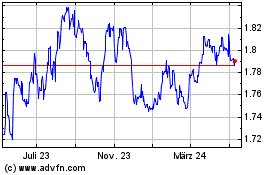Australia, NZ Dollars Decline Amid Rising Risk Aversion
26 März 2015 - 6:10AM
RTTF2
The Australian and New Zealand dollars continued to be weak
against their major currencies in the Asian session on Thursday
amid risking risk aversion following the sell-off overnight on Wall
Street and amid concerns about the political situation in Yemen
after Saudi Arabia and its allies began airstrikes in that country.
Soft U.S. U.S. durable goods orders report showing a more than
expected drop in February on Wednesday soured sentiment.
Data from the Commerce Department showed that U.S. durable goods
orders fell by 1.4 percent in February following a downwardly
revised 2.0 percent increase in January. Economists had expected
orders to climb by 0.7 percent compared to the 2.8 percent jump
that had been reported for the previous month.
Investors also monitored the political turmoil in Yemen. Saudi
Arabia and its Gulf Arab allies launched air strikes on Yemen
Wednesday against Houthi fighters who have tightened their grip on
the the nearby port city of Aden, where the country's president
Abdu Rabu Mansour Hadi had taken refuge.
Wednesday, the Australia and New Zealand dollars fell against
their major rivals. The Australian dollar fell 0.40 percent against
the U.S. dollar, 0.63 percent against the yen, 0.32 percent against
the euro and 0.20 percent against the Canadian dollar. The NZ
dollar also fell 0.65 percent against the U.S. dollar, 0.84 percent
against the yen and 0.52 percent against the euro.
In the Asian trading today, the Australian dollar fell to an
8-day low of 1.4044 against the euro and a 6-day low of 93.19
against the yen, from yesterday's closing quotes of 1.3978 and
93.69, respectively. If the aussie extends its downtrend, it is
likely to find support around 1.43 against the euro and 91.70
against the yen.
Against the U.S. and the Canadian dollars, the aussie dropped to
3-day lows of 0.7806 and 0.9773 from yesterday's closing quotes of
0.7840 and 0.9815, respectively. The aussie may now test support
near 0.75 against the greenback and 0.96 against the loonie.
The NZ dollar also fell to a 1-week low of 1.4483 against the
euro in the Asian trading today, from yesterday's closing value of
1.4411. If the kiwi extends its downtrend, it is likely to find
support around the 1.48 area.
Against the yen and the U.S. dollar, the kiwi slipped to a 6-day
low of 90.37 and a 3-day low of 0.7569 from yesterday's closing
quotes of 90.84 and 0.7601, respectively. On the downside, 88.12
against the yen and 0.72 against the greenback are seen as the next
support levels for the kiwi.
Looking ahead, German Gfk consumer confidence for April, Swiss
KOF Spring economic forecast and Eurozone M3 money supply and U.K.
retail sales- both for February are due to be released in the
European session.
At 4:35 am ET, U.S. Federal Reserve Bank of St. Louis President
James Bullard is expected to give OMFIF Public Lecture on the
economy and monetary policy in Frankfurt.
In the New York session, U.S. weekly jobless claims for the week
ended March 21 and Markit's U.S. PMI reports for March are slated
for release.
At 9:00 am ET, U.S. Federal Reserve Bank of Atlanta President
Dennis Lockhart will deliver a speech about the economic outlook
and monetary policy at the Engage International Investment
Education Symposium, in Detroit.
Subsequently, European Central Bank president Mario Draghi will
address the Italian parliament's finance and EU policy committees
in Rome at 9:15 am ET. After 15 minutes, Bank of Canada Governor
Stephen Poloz is expected to speak at the Canada-UK Chamber of
Commerce, in London.
At 1:30 pm ET, Bank of England Governor Mark Carney will hold a
press conference about his role as Chair of the Financial Stability
Board, in Frankfurt. After half-an-hour, Swiss National Bank member
Fritz Zurbrugg will deliver a speech about monetary policy after
the cap at the Money Market Event, in Zurich.
Euro vs NZD (FX:EURNZD)
Forex Chart
Von Mär 2024 bis Apr 2024

Euro vs NZD (FX:EURNZD)
Forex Chart
Von Apr 2023 bis Apr 2024
